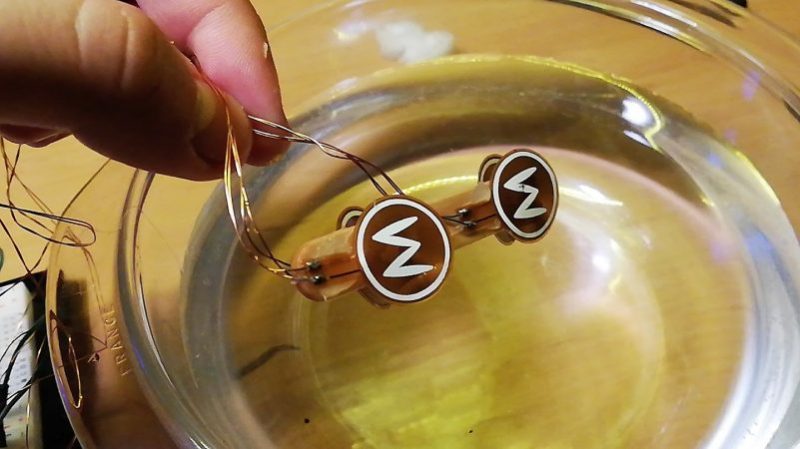We love a little outside-the-box thinking around here, and anytime we see robots that don’t use wheels and motors to do the moving, we take notice. So when a project touting robotic fish using soft-actuator fins crossed the tip line, we had to take a look.
It turns out that this robofish comes from the fertile mind of [Carl Bugeja], whose PCB motors and flexible actuators have been covered here before. The basic concept of these fish fins is derived from the latter project, which uses coils printed onto both sides of a flexible Kapton substrate. Positioned near a magnet, the actuators bend when a current runs through them. The video below shows two prototype robofish, each with four fins. The first is a scrap of foam with a magnet embedded; the fins did flap but the whole thing just weighed too much. Version two was much lighter and almost worked, but the tether to the driver is just too stiff to allow it to really flex its fins.
It looks like it has promise though, and we’re excited to see where [Carl] take this. Perhaps schools of tiny robofish patrolling for pollution?
















This would have been interesting if he used even simple electronics and something like a button cell battery and made it autonomous. Watching a popsicle stick with the little flat coils on it not move because of the heavy wires going to it was just not at all impressive.
It’s a proof of concept.
This is very promising future tech, if followed through to full conclusion and by that I mean. Fish swim well, because they have a ‘swim’ bladder and the same thing applies to whales, just as it does to a minnow. It’s ot a complicated device in principle but by adding one. The problem of ‘tethers’ inherent here, could be overcome methinks.
He should combine several coils to make fins with more complex movement if he wants to get the thing moving forward. Fish don’t just flap back and forth. Very cool project!
Well, they do… kind off.. I wonder if he made the fins longer, if they would work better. For a quick experiment he could use some tape to extend the fins. The tape allows for more surface area and is more flexible then the PCB that does the movement. Just in real life, fins are sturdy at the beginning and very thin and flexible at the end. They are so for a reason.
I say this because in essence, the flippers that divers put onto their feet work perfectly fine while the diver essentially flaps his feet up and down. I could be wrong (would not be the first time) but I think it is a simple test and therefore worth a try.
I was also wondering about the wires, if the force of the wires exceeds the force of the flippers, the flippers will not appears to do much for the movement of the craft. So perhaps to cancel this out he could coils the wires (just like a telephone cord).
Anyway, interesting project.
I don’t think it’s that easy to propel with fins. For example try to extend fully your hands in water and swing them forward and backward. The net movement will be zero. When we swim underwater, we contract our hands to bring them again in the extend position in order to push back the water, so in this case it would need a smarter design, maybe foldable fins that would expand only in the push back movement and would contract in the returning movement.
Been there done that and even got a video. It is IR remote controlled and self contained. Not the most elegant movement, but prove the point that a single fin driven from a servo can indeed propel a boat and even steer. The trick is controlling the speed as well as the steering angle.
BTW: Real boats exist that do just that: https://en.wikipedia.org/wiki/Sampan
https://www.youtube.com/watch?v=o3URDO6IZC0
My project page for the boat:
https://hw-by-design.blogspot.com/2018/08/single-servo-for-propulsion-and-steering.html
github: https://github.com/FPGA-Computer/rowboat
Except that fish is propelling itself with the body and only use fins to navigate/orientate. The examples above is a bit like driving a car by only turning the steering wheel.
em…..It will be a prefect lura ,if it can study how to swim like real fish.